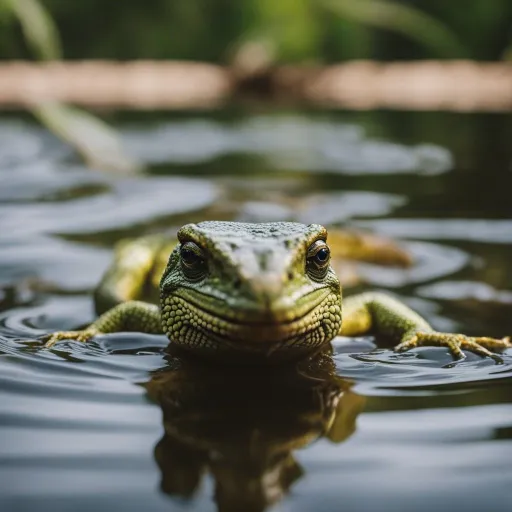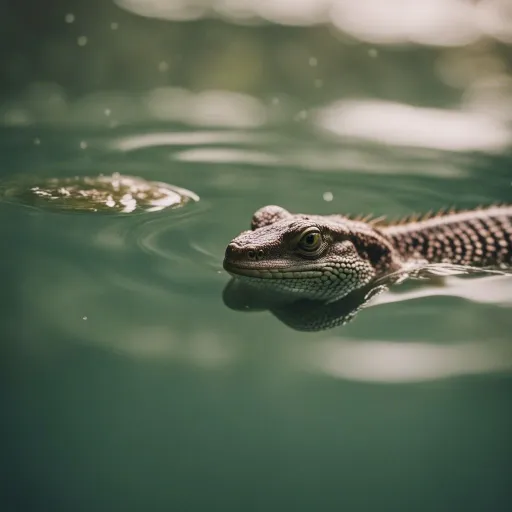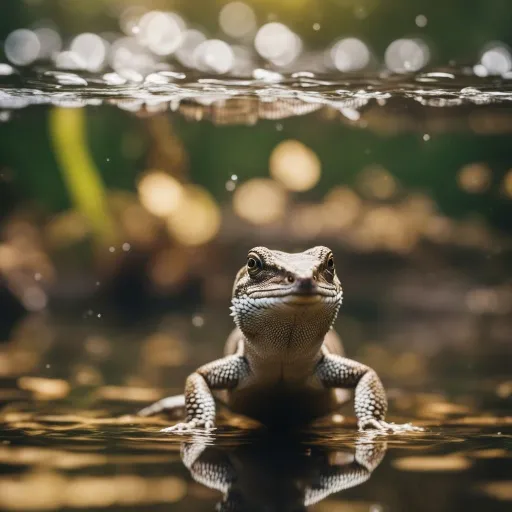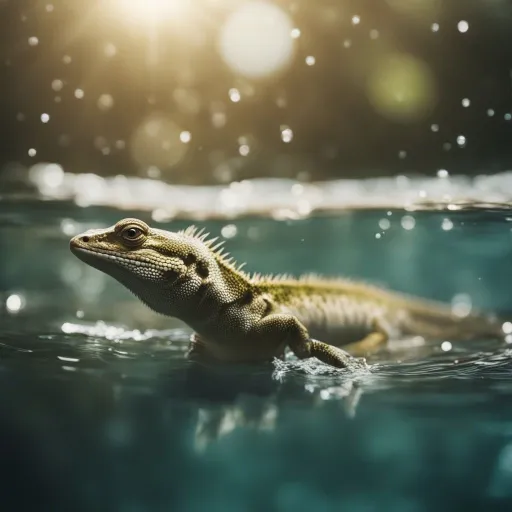Imagine a scorching hot summer day, where the sun blazes overhead and the air shimmers with heat. You find yourself near a tranquil pond, surrounded by lush, green vegetation.
As you gaze into the water, a thought crosses your mind – can lizards swim in water? This article will explore the fascinating world of lizards and uncover the truth behind their amphibious abilities.

Swimming Abilities of Lizards
Lizards are known for their agility and ability to navigate various terrains, but did you know that some lizards are also capable swimmers?
While not all lizard species possess this skill, there are several adaptations and behaviors that enable certain lizards to thrive in aquatic environments.
In this article, we will explore the general swimming abilities of lizards, the adaptations that contribute to their swimming proficiency, the different lizard species that are known to swim, their swimming techniques, and the role of swimming in lizard evolution.
General swimming abilities
Not all lizards are natural-born swimmers, but those that can swim often exhibit impressive aquatic skills.
Swimming allows these lizards to explore new habitats, find food sources, and escape predators.
While some lizards may only swim short distances, others are capable of traversing across bodies of water with considerable ease.
These swimming abilities vary among different lizard species and depend on several factors such as tail shape, body morphology, and the presence of webbed feet or toes.
Variations in swimming proficiency
Among lizard species that can swim, there is a considerable variation in swimming proficiency.
Some lizards have evolved to be highly proficient swimmers, spending a significant amount of time in water and exhibiting specialized adaptations for swimming.
On the other hand, some lizards may be less proficient swimmers, utilizing swimming as a means of survival only when necessary.
The level of swimming proficiency can be influenced by factors such as habitat, diet, and evolutionary history.

Adaptations for Swimming
Tail shape and size
The shape and size of a lizard’s tail play a crucial role in its swimming abilities. Lizards with laterally compressed tails, resembling the shape of a paddle, are often well-suited for swimming.
This tail shape allows for efficient propulsion through the water, enabling the lizard to navigate with agility.
Additionally, a long and muscular tail provides stability and balance during swimming, contributing to overall swimming proficiency.
Body morphology
The body morphology of aquatic lizards differs from their terrestrial counterparts. Aquatic lizards tend to have a streamlined body shape, reducing drag in the water and allowing for faster and more efficient swimming.
Their limbs may also be modified, with shorter and more robust limbs ideal for propulsion.
These adaptations enable aquatic lizards to move through water with minimal resistance and increased agility.
Webbed feet or toes
Some aquatic lizards possess webbed feet or toes, which aid in swimming by increasing surface area and enhancing propulsion.
The webbing acts as paddles, generating additional thrust as the lizard moves through the water.
This adaptation is particularly beneficial for lizards that inhabit freshwater or marine environments, as it allows them to navigate through currents and maintain stability while swimming.
Lizard Species that Swim
Water anoles
Water anoles, also known as water lizards, are a group of lizards that are well-adapted for aquatic life.
They are native to various regions, including Central and South America. Water anoles have long, slender bodies, with specialized scales that repel water, enabling them to move through the water effortlessly.
These lizards are proficient swimmers and can often be found near streams, ponds, and other water bodies.
Marine iguanas
Marine iguanas are iconic inhabitants of the Galapagos Islands, known for their unique adaptation to a marine lifestyle.
These lizards are capable of diving underwater, using their long, powerful tails as propellers. They rely on their strong limbs to swim through the rough ocean currents in search of their primary food source, marine algae.
Marine iguanas are truly remarkable swimmers, demonstrating the extent to which lizards can adapt to different environments.
Crocodile monitors
Crocodile monitors, native to New Guinea, are the world’s longest lizard species and are also proficient swimmers.
These lizards have adapted to their semi-aquatic lifestyle by developing a long, muscular tail for propulsion and a streamlined body shape.
Crocodile monitors can often be found near riverbanks and other freshwater habitats, where they use their swimming abilities to forage for food and evade potential threats.
Water dragons
Water dragons, commonly found in Southeast Asia, are semi-aquatic lizards known for their excellent swimming abilities.
These lizards have long, muscular tails and strong limbs, enabling them to navigate through water bodies with ease.
They inhabit freshwater habitats such as rivers, creeks, and ponds, where they bask on rocks at the water’s edge and dive into the water when threatened.
Water dragons are impressive swimmers and are well-adapted to their aquatic lifestyle.
Geckos
While not all gecko species are known for their swimming abilities, some geckos have developed adaptations that allow them to navigate through water.
For example, the Asian house gecko possesses adhesive toe pads that provide them with the ability to crawl on walls and ceilings.
These toe pads also aid in swimming, allowing geckos to cling to surfaces in water bodies and move through the water.
Geckos demonstrate the diverse range of lizards that have evolved to utilize swimming in their daily lives.

Swimming Techniques
Paddling with limbs
One of the most common swimming techniques employed by aquatic lizards is paddling with their limbs. Lizards that have not evolved specialized adaptations for swimming often rely on their limbs to generate propulsion and maneuver through water.
By alternating the movement of their forelimbs and hindlimbs, these lizards can paddle through the water, propelling themselves forward.
Undulating body movements
Aquatic lizards with a more streamlined body shape often utilize undulating body movements to swim efficiently.
These lizards flex and bend their bodies, creating a wave-like motion that propels them through the water.
This technique allows for a continuous and smooth swimming motion, minimizing drag and allowing for increased swimming speed.
Propulsion methods
Different aquatic lizards employ various propulsion methods to swim effectively. Some lizards rely on their powerful tails to generate forward thrust, using their limbs primarily for steering and stabilization.
Other lizards use a combination of tail propulsion and limb paddling to achieve efficient swimming.
The specific propulsion methods utilized by a lizard depend on its anatomy, evolutionary adaptations, and ecological niche.
Swimming as a Defense Mechanism
Evading predators
One of the primary reasons why certain lizards have evolved the ability to swim is to evade predators. By utilizing their swimming skills, lizards can escape from terrestrial predators that are unable or hesitant to pursue them into the water. Swimming allows them to access areas that may be inaccessible to their pursuers and increases their chances of survival.
Escaping dangerous situations
In addition to evading predators, swimming also enables lizards to escape from dangerous situations such as floods or extreme heat. During floods, lizards that can swim have a distinct advantage over non-swimming species as they can move to higher ground or find refuge on floating debris. Similarly, in hot and arid regions, lizards may cool off and seek shelter in water bodies, providing them with relief from harsh environmental conditions.

Habitats and Environments
Freshwater habitats
Freshwater habitats such as rivers, streams, lakes, and ponds provide ideal environments for many aquatic lizards. These habitats offer a steady source of water and often support diverse ecosystems, attracting a wide range of prey species. Aquatic lizards that inhabit freshwater environments have adapted to the specific conditions and requirements of these habitats, allowing them to thrive in these areas.
Marine and saltwater habitats
While freshwater habitats are more common for aquatic lizards, there are also species that have adapted to marine and saltwater environments. Marine iguanas, for example, are known to inhabit coastal regions and feed on marine algae. These lizards are capable of withstanding the harsh conditions of the ocean, including saltwater and strong currents. Their ability to swim in marine environments showcases the adaptability of lizards to a variety of habitats.
Swimming Efficiency and Speed
Comparison to other aquatic animals
When comparing swimming efficiency and speed, lizards may not match the performance of specialized aquatic animals, such as fish or marine mammals. However, they have developed unique adaptations that allow them to swim sufficiently for their specific ecological niche. Lizards may not exhibit the same speed or endurance as fully aquatic creatures, but their swimming abilities are often impressive given their terrestrial origins.
Factors affecting swimming efficiency
Several factors can influence the swimming efficiency of lizards. These include their morphology, tail shape, muscle structure, and adaptations for aquatic locomotion. Lizards with streamlined bodies, long tails, and strong limbs are generally more efficient swimmers. Environmental factors such as water temperature and visibility can also impact swimming efficiency, as lizards may adjust their swimming behavior or speed accordingly.
Implications for Conservation
Understanding behavioral adaptations
Studying the swimming abilities and adaptations of lizards can provide valuable insights into their ecology, behavior, and overall survival strategies. Understanding how different species utilize swimming can help researchers and conservationists in developing effective conservation plans for these reptiles. By considering the specific swimming needs and habitat requirements of aquatic lizards, conservation efforts can be better targeted to protect these unique and often threatened species.
Protecting aquatic lizard habitats
Conserving the habitats of aquatic lizards is crucial for maintaining their populations and preserving their swimming abilities. Destruction of freshwater habitats, pollution, and overfishing can have detrimental effects on the overall health and well-being of these ecosystems. By implementing measures to protect and restore these habitats, we can ensure that the aquatic lizards and other species that rely on them for survival can continue to thrive.

The Role of Swimming in Lizard Evolution
Evolutionary origins of swimming capability
The ability to swim in lizards is believed to have evolved independently multiple times within different lineages.
This suggests that swimming as a mode of locomotion has been advantageous for certain lizard species in various ecological contexts.
The evolutionary origins of swimming capability in lizards can be traced back to their ancestors’ adaptations for terrestrial locomotion and the subsequent modifications that allowed them to exploit aquatic environments.
Diversification of aquatic lizard species
The existence of numerous aquatic lizard species highlights the success and diversification that can occur when lizards inhabit aquatic habitats.
Over time, different populations of lizards have developed unique adaptations and swimming techniques to thrive in their respective environments.
The diversification of aquatic lizard species has contributed to the overall biodiversity of reptiles and provides fascinating examples of evolutionary adaptation and ecological specialization.
Final Thoughts
In conclusion, the swimming abilities of lizards demonstrate the remarkable adaptability of these reptiles to various environments.
While not all lizard species are capable swimmers, those that can swim have evolved specialized adaptations for aquatic locomotion.
Through tail shape and size, body morphology, and the presence of webbed feet or toes, aquatic lizards have honed their swimming skills to navigate freshwater and marine habitats.
Swimming serves as both a defense mechanism and a means of accessing resources, allowing these lizards to thrive in diverse ecological niches.
The study of lizard swimming abilities provides valuable insights into their evolution, behavior, and the importance of conservation efforts to protect their habitats.
As we continue to explore the depths of lizard swimming capabilities, it becomes increasingly evident that further research in this field is crucial for our understanding of the natural world.



